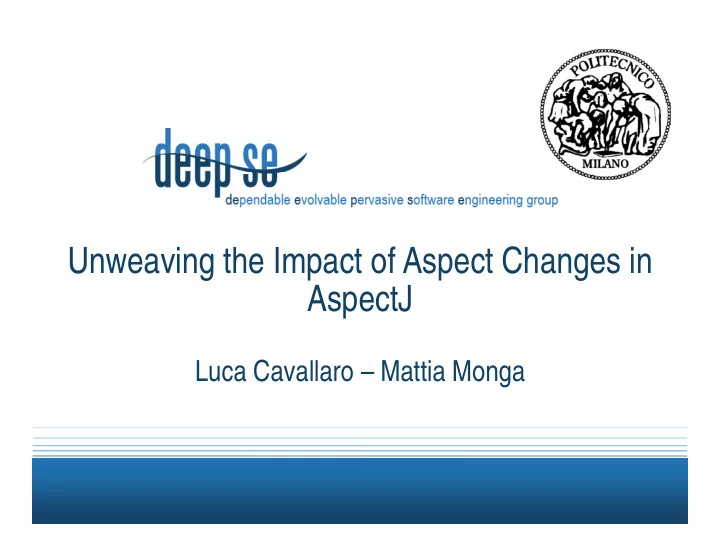

Unweaving the Impact of Aspect Changes in AspectJ p Luca Cavallaro – Mattia Monga g
Problem Outline Problem Outline • Small changes can have major and nonlocal effects in programs • For Aspect Oriented software the problem is even more relevant for the obliviousness is even more relevant, for the obliviousness of Aspect oriented programs • Local changes are not really local • Local changes are not really local – Changes in the base system Influence Aspects and vice versa!
Problem solution: Change Impact Analysis Problem solution: Change Impact Analysis • We suppose to have two versions of the same program and a test suite • We run tests on two versions of the program • We compare source of two versions to find “atomic changes” – “Small” changes in program source Small changes in program source – There are interdependencies between atomic changes • We compare graph representation of the two program versions
Change impact analysis overview Change impact analysis overview • We find dangerous paths and map them on atomic changes g • An atomic change – in dangerous paths is responsible for test result change g p p g – not mapped on dangerous edges do not to affect test result – not mapped on any test in the suite is not tested • Deleting a set of AC in dangerous paths produces a version of the program giving previous test result lt
Running example Running example
Running example Running example
Running example • Bound point aspect: B d i t t – A pointcut to capture setX and methods that calls it – A pointcut to capture setX calls only p p y – We add a field in modified version // ====== advices ====== before (Point p, int x) throws InvalidException: setterX(p) && args (x) { // before } void around (Point p): setterX(p) { //around1 } void around (Point p): setterXonly(p) p y p { // around2} before (Point p): setterX(p){ // before2 //modified to use added field } after (Point p) throwing (Exception ex): setterX(p) { // afterThrowing1 } after (Point p): setterX(p){ after (Point p): setterX(p){ // // after1 }
Test Case Test Case public static void main(String[] a) throws Exception { Point p1 = new Point(); p1.setRectangular(5,2); System out println("p1 = " + p1); System. out .println( p1 = + p1); if (p1.x> 5){ p1.setX(6); p1.setY(3); System. out .println("p1 = " + p1); y p ( p p ); } else { System. out .println("p1 = " + p1); } Point p2 = new PointExt(); p2.setRectangular(5,2); System. out .println("p2 = " + p2); p2.setX(5); } }
Atomic changes example Atomic changes example
AspectJ interaction Graph AspectJ interaction Graph • We use the AspectJ Interaction Graph (AJIG) to represent program semantics (AJIG) to represent program semantics • Control flow representation of an AspectJ p p program • Three main kinds of interactions: Three main kinds of interactions: –Non-advice method calls –Interactions between advices and methods th d –Introductions and intertype declarations
Example Example • Dangerous edge1 is due to CAB of Before2 CAB of Before2 – It is mapped on CBM and AF • Dangerous edge 2 is due to Dangerous edge 2 is due to the LC PointExtm Point.setX() – It is mapped on two AC: It is mapped on two AC: LC, AM
Implementation Implementation • We implemented change impact analysis for AspectJ on top of abc and Ajana for AspectJ on top of abc and Ajana • abc is an extensible AspectJ compiler – Built on top of Soot and Polyglot Built on top of Soot and Polyglot – Allows to access program AST and to implement analysis – Due to two phases weaving we could analyze Due to two phases weaving we could analyze AspectJ programs without considering instructions added by the compiler • Ajana is a framework for AspectJ analysis Ajana is a framework for AspectJ analysis – Provides AJIG representation
Future work Future work • We produced and implemented an approach that helps the programmer maintaining code helps the programmer maintaining code – Source code changes are decomposed into atomic changes and are related – Change in tests results are mapped on source code Change in tests results are mapped on source code changes • For future work we plan to rise abstraction level – Build changes classifiers Build changes classifiers – Classify possible changes following anti-patterns classification – Several work try to build metrics for changes in AO Several work try to build metrics for changes in AO programs
Recommend
More recommend